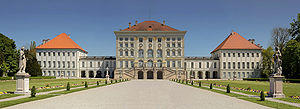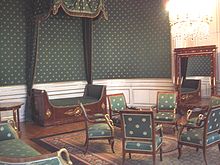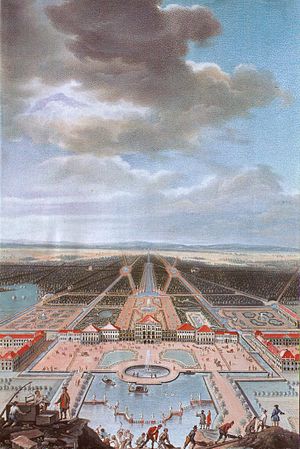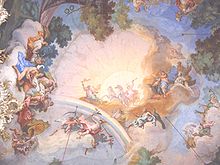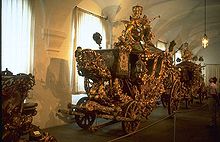- Nymphenburg Palace
-
The Nymphenburg Palace (German: Schloss Nymphenburg), i.e. "Nymph's Castle", is a Baroque palace in Munich, Bavaria, southern Germany. The palace was the main summer residence of the rulers of Bavaria.
Contents
History
 Nymphenburg Palace, around 1760, as painted by Canaletto.
Nymphenburg Palace, around 1760, as painted by Canaletto.
The palace was commissioned by the prince-electoral couple Ferdinand Maria and Henriette Adelaide of Savoy to the designs of the Italian architect Agostino Barelli in 1664 after the birth of their son Maximilian II Emanuel. The central pavilion was completed in 1675.
Starting in 1701, Max Emanuel, the heir to Bavaria, a souvereign electorate of the Holy Roman Empire, conducted a systematic extension of the palace. Two pavilions were added each in the south and north of Barelli's palace by Enrico Zucalli and Giovanni Antonio Viscardi. Later, the south section of the palace was further extended to form the court stables. As a balance, the orangerie was added to the north. Finally, a grand circle (the Schlossrondell) with baroque mansions (the so-called Kavaliershäuschen - cavalier's lodges) was erected under Max Emanuel's son Holy Roman Emperor Charles VII Albert. Two of the latter's children were born here; Maria Antonia (future Electress of Saxony) in 1724 and Maria Anna Josepha (future Margravine of Baden-Baden) in 1734.
Birthroom of King Ludwig II of Bavaria.
Joseph Effner redesigned the facade of the center pavilion in French baroque style with pilasters in 1716. In 1826 Leo von Klenze removed its gables with the electoral coat of arms and created an attic decoration directly under the roof instead.
With the Treaty of Nymphenburg signed in July 1741, Charles Albert allied with France and Spain against Austria. For a long time, the palace was the favourite summer residence of the rulers of Bavaria. King Max I Joseph died there in 1825, and his great-grandson King Ludwig II was born there in 1845.
Today, Nymphenburg is open to the public, but also continues to be a home and chancery for the head of the house of Wittelsbach, currently Franz, Duke of Bavaria. To Jacobites, who trace the line of legitimate British monarchy down through the legal heirs of James II of England, the head of the house of Wittelsbach is the legitimate heir of the Stuart claims to the throne of the United Kingdom of Great Britain and Northern Ireland, which claim is not, however, currently being actively pursued.
The Palace
The palace, together with its park, is now one of the most famous sights of Munich. The baroque facades comprise an overall width of about 700 metres. The Steinerner Saal (Stone Hall), with ceiling frescoes by Johann Baptist Zimmermann and F. Zimmermann and decorations by François de Cuvilliés, is an impressive sight. Acting as a grand hall, it occupies over three floors of the central pavilion of the palace.
Some rooms still show their original baroque decoration while others were later redesigned in rococo or neoclassical style. The former small dining room in the south pavilion today houses the Gallery of Beauties of King Ludwig I of Bavaria. This pavilion houses also the birthroom of King Ludwig II of Bavaria.
The court stables contain one of the most important museums of ancient carriages (Marstallmuseum). They also played a part in historical events - the Paris Coronation Coach for example was used for the coronation of Emperor Charles VII in 1742. Among the main attractions of the museum are the magnificent carriages and sleighs of King Ludwig II.
The first floor of the former court stables houses a collection of Nymphenburg porcelain, the factory which, also located in the palace complex, was founded by Maximilian III Joseph. It's handcrafted products are of legendary kind and quality, nowadays said to be comparable to Augarten and Sèvres only.
The Park


The 200-hectare (490-acre) park, once an Italian garden (1671), which was enlarged and rearranged in French style by Dominique Girard, a pupil of Le Notre, was finally redone in the English manner during the early 19th century by Friedrich Ludwig von Sckell, on behalf of prince-elector Charles Theodore. von Sckell was also the creator of the English Garden in Munich. He preserved the main elements of the Baroque garden (such as the grand parterre). The park is bisected by a long canal along the principle axis which leads from the palace to the marble cascade (decorated with stone figures of Greek gods) in the west. The garden wall (1730–1735) saves several Ha-ha effects.
Two lakes are situated on both sides of the canal. The "Dörfchen" was created under Maximilian III Joseph as Petit hameau. The "Salettl" (1799), a cottage with its little garden nearby close to the former menagerie served as attraction for the children of Maximilian IV Joseph.
The fountains in front of the palace and in the garden parterre continue to be operated by the water powered Pumping Stations built between 1803 and 1808.
Within the park, a number of pavilions were built:
- the Pagodenburg (1716–1719) - an octagonal, two story pavilion with Delft tile decoration downstairs and Chinoiserie upstairs. It was built by Joseph Effner.
- the Badenburg (1719–1721) - a Baroque pavilion also by Joseph Effner. It contains a grand banqueting hall and a very large tiled bath. Some rooms are decorated with various Chinese wallpapers.
- the Magdalenenklause - a faux ruin for retreat and meditation, erected between 1725 and 1728.
- the Amalienburg - a Rococo hunting lodge constructed in 1734-1739 by François de Cuvilliés for Charles VII and his wife, Maria Amalia, including a hall of mirrors and a kennel room for the hunting dogs. The building with its decoration is a definite masterpiece on the climax of European rococo.
- the Apollotemple - a neoclassical temple by Leo von Klenze, erected in 1862-1865
A passage close to the old arboretum in the north of the Grand Parterre leads to the large Botanical Garden of Munich.
Tourism
The main building alone has more than 300,000 visitors per year. Nymphenburg Palace lies ahead the Munich Residence and Schleissheim Palace, but clearly behind the castles of King Ludwig II, especially Neuschwanstein.
Schloss Nymphenburg is accessible by Munich public transport's tram number 17. This line passes through the city centre, including Stachus and the main train station.
Miscellaneous
The palace and its park were some of the main filming locations of Alain Resnais's 1961 movie Last Year at Marienbad. The Dressage Facility for the equestrian events of the 1972 Summer Olympics was created in the Nymphenburg park.[1]
The palace serves also as headquarters of the Bavarian Administration of State-Owned Palaces, Gardens and Lakes.
Images
-
The Chinese Cabinet with chinoiserie, one of the rooms of Nymphenburg Palace
See also
- List of Baroque residences
References
- ^ 1972 Summer Olympics official report. Volume 2. Part 2. pp. 206-7.
External links
Coordinates: 48°09′29″N 11°30′13″E / 48.158056°N 11.503611°E
- Nymphenburg Palace official website
- Nymphenburg Palace
- 360° Panorama Nymphenburg Palace
- Review of the palace
Ludwig II of Bavaria's buildings Palaces/castles built Others Venues of the 1972 Summer Olympics Olympiapark Boxhalle · Hockeyanlage · Olympiahalle · Olympiastadion · Olympisches Dorf · Radstadion · Schwimmhalle · VolleyballhalleGreater Munich Basketballhalle · Bogenschießlage · Dantebad · Dressage Facility Nymphenburg · Grünwald · Messegelände, Fechthalle 1 · Messegelände Fechthalle 2 · Messegelände, Gewichtheberhalle · Messegelände, Judo- und Ringerhalle · Regattastrecke Oberschleißheim · Riding Facility, Riem · SchießanlageFootball venues Drei Flüsse Stadion (Passau) · ESV-Stadion (Ingolstadt) · Jahnstadion (Regensburg) · Rosenaustadion (Augsburg) · Urban Stadium (Nuremberg)Handball venues Other venues Categories:- 1660s architecture
- 1972 Summer Olympic venues
- Olympic equestrian venues
- Royal residences in Bavaria
- Palaces in Bavaria
- Buildings and structures in Munich
- Parks in Germany
- Heritage sites in Bavaria
- Baroque architecture in Munich
- Baroque palaces
- Protected areas of Bavaria
- Museums in Munich
- Historic house museums in Germany
Wikimedia Foundation. 2010.

